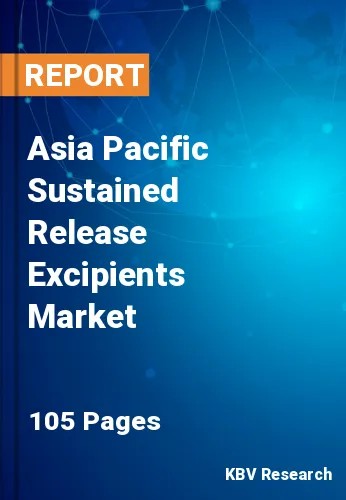The Asia Pacific Sustained Release Excipients Market would witness market growth of 9.0% CAGR during the forecast period (2022-2028).
Hydrophobic matrix systems employ polymers that are insoluble in water and exhibit little to no swelling. The outer liquid penetrates the matrix, dissolving the medication, with the porosity directly affecting the release kinetics. The active substance is uniformly mixed with the discharge controlling material in matrix systems of the sustained release procedure. This reduces the risk of dose accumulation compared to coated formulations, making the release pattern less sensitive to dosage form surface damage, and in some cases even allowing for tablet division.
The sustained release excipients have gained attention as patent expirations increased, making the testing of formerly registered drugs for this method possible. A rise in the need for dosage forms for the elderly and pediatric populations also governs the advancements of sustained release methodology. As patient expectations for greater convenience rise, so does the demand for controlled-release formulations.
The awareness about these drugs among people has also motivated drug development companies to invest in their R&D more. Long-term treatment for the therapy of chronic disorders necessitates the frequent administration of conventional formulations in a variety of dosage regimens, which has significant adverse consequences. As a result, tablets and other sustained-release solid unit dose forms are necessary to mitigate the drawbacks of multiple dosing.
More than half of the world's population lives in the Asia Pacific region, which carries a large share of the burden of infectious diseases (IDs), particularly in poorer nations. In addition to the enduring threat of common infections like HIV, tuberculosis (TB), malaria, hepatitis, and diarrheal diseases, the region is also experiencing an increase in non-communicable diseases (NCDs) because of aging populaces and lifestyle changes. Changes in socioeconomic status in the region as the linkages between non-communicable and infectious illnesses become more obvious to the general public and the medical community, in which COVID-19 marked a pivotal moment in the public health strategy.
The China market dominated the Asia Pacific Sustained Release Excipients Market by Country in 2021; thereby, achieving a market value of $151 million by 2028. The Japan market is poised to grow at a CAGR of 8.3% during (2022 - 2028). Additionally, The India market would experience CAGR of 9.7% during (2022 - 2028).
Based on Route of Administration, the market is segmented into Oral, Transdermal, Vaginal, Intravenous, Ophthalmic, Subcutaneous, Intramuscular, and Others. Based on Product, the market is segmented into Polymers, Minerals, Sugars, Gelatin & Chitosan, and Others. Based on Technology, the market is segmented into Targeted Delivery, Implants, Wurster Technique, Transdermal, Micro Encapsulation, and Coacervation & Others. Based on countries, the market is segmented into China, Japan, India, South Korea, Singapore, Malaysia, and Rest of Asia Pacific.
Free Valuable Insights: The Worldwide Sustained Release Excipients Market is Projected to reach USD 1.9 Billion by 2028, at a CAGR of 8.4%
The market research report covers the analysis of key stake holders of the market. Key companies profiled in the report include BASF SE, International Flavors & Fragrances, Inc., Ashland Global Holdings Inc., Evonik Industries AG, Croda International Plc, Gattefossé, Merck Group, Pfizer, Inc., Novartis AG and AstraZeneca Plc.
By Route of Administration
By Product
By Technology
By Country
Our team of dedicated experts can provide you with attractive expansion opportunities for your business.

